the place where Paleontology and Paleoanthropology meets Philately
New Zealand
Fossils, dinosaurs and other prehistoric animals on stamps and postmarks of New Zealand
| << previous country | back to index | next country >> |
Contents:
- Country overview
- Philately of New Zealand
- Official stamps of New Zealand related to Paleontology
- Some other stamps of New Zealand to consider
- Commemorative postmarks of New Zealand related to Paleontology
- References
- Acknowledgements
New Zealand is an island nation in the southwestern Pacific Ocean. The country geographically comprises two main landmasses—that of the North Island, or Te Ika-a-Māui, and the South Island, or Te Waipounamu—and numerous smaller islands.
New Zealand is situated some 1,500 kilometres east of Australia across the Tasman Sea and roughly 1,000 kilometres south of the Pacific island areas of New Caledonia, Fiji and Tonga.
Because of its remoteness, it was one of the last lands to be settled by humans. During its long period of isolation, New Zealand developed a distinctive biodiversity of animal, fungal and plant life.
The country's varied topography and its sharp mountain peaks, such as the Southern Alps, owe much to the tectonic uplift of land and volcanic eruptions.
New Zealand's capital city is Wellington, while its most populous city is Auckland. Population of the county is about 4,7 million.
In 1840, Maori Chieftains entered into a compact with Britain, the Treaty of Waitangi, in which they ceded sovereignty to Queen Victoria while retaining territorial rights.
The British colony of New Zealand became an independent dominion in 1907 and supported the UK militarily in both world wars.
[R1]
 |
| One of the definitve stamps from 1898 shiws the scenery of Lake Wakatipu, MiNr.: 69, Scott: 74 |
In 1898 New Zealand's Post issued the set of definitive stamps depicting sceneries of the country, which made New Zealand one of the first countries in the world to feature scenic views on its stamps.
New Zealand was the first country in the world to prototype and install stamp vending machines; one was installed in the General Post Office, Wellington in 1905. [R2]
Official stamps of New Zealand related to Paleontology: fossils, dinosaurs and other prehistoric animals
| 01.02.1984 "Antarctic Research" [1] | 01.10.1993 "Dinosaurs" [2] | |
 |
 |

|
| 03.03.2010 "Ancient Reptiles of New Zealand" (mint and self-adhesive mini-sheet) | 02.11.2022 Woman in Science | |
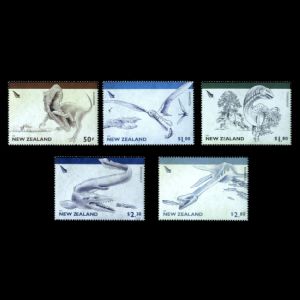
|
 |
 |
Notes:
[1] Plant fossil shown on one of the "Antarctic research" stamps of New Zealand 1984, MiNr.: 889, Scott: 791.

[2] On October 10, 1993, only three month after release of "Jurassic Park" movie, three commonwealth countries: Australia, Canada and New Zealand issued stamps with prehistoric animals.


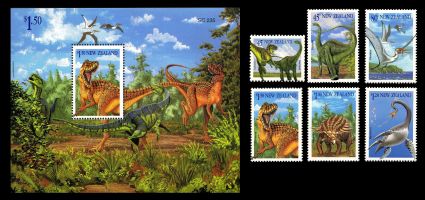
Some other stamps of New Zealand: Natural History Museum, contributors to Paleontology
| 10.10.1967 "Century of Royal Society of New Zealand" [A1] | 11.02.1998 "Opening of Te Papa Museum of New Zealand in Wellington" [A2] | 04.06.2025 "Soil - The Foundation of Life Set" [A3] |
 |
 |
 |
Notes:
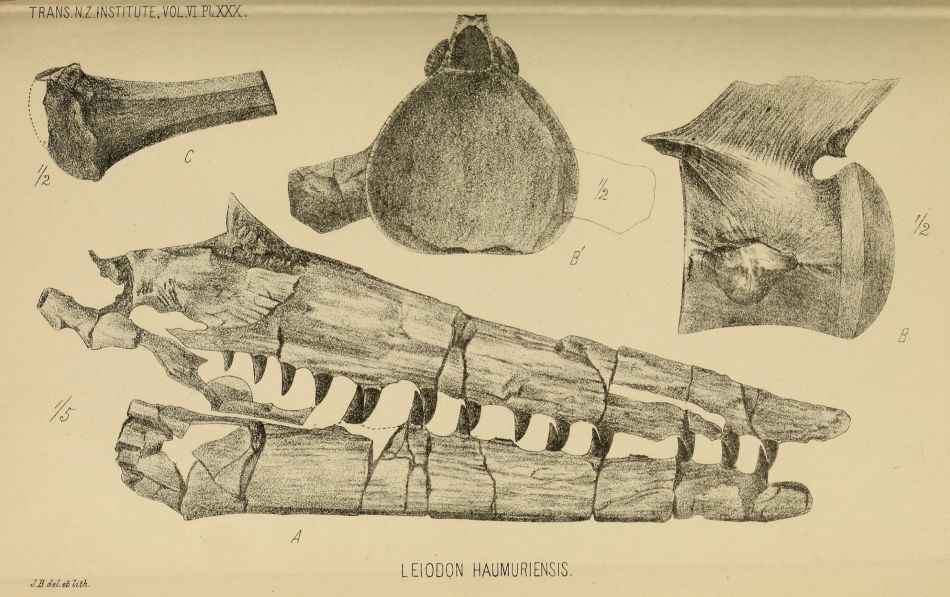 |
| In 1874 James Hector described some Mosasaur remains, now known as Taniwhasaurus haumuriensis. |
James Hector was the dominating personality in the small, nineteenth century scientific community in New Zealand. Appointed as the government‟s first professional scientist in 1865, he quickly established the New Zealand Geological Survey (now GNS Science), the Colonial Museum (now Te Papa) and the New Zealand Institute (now Royal Society of New Zealand) as well as becoming a trusted government advisor. Until he retired in 1903, Hector wrote and published a huge amount of material including scientific papers, official parliamentary reports, and annual reports for the organisations under his control as well as supervising the publication of scientific material in the annual Transactions of the New Zealand Institute and the Reports of Geological Exploration.
In 1874, he reported about some fossil discoveries in New Zaland : "The first notice of the occurrence in New Zealand strata of representatives of the Reptilian fauna characteristic of the mesozoic epoch, was made in 1861, when Professor Owen communicated to the British Association a brief description of certain fossils that had been discovered by Mr. T. H. Cockbvirn Hood, P.G.S., and presented by him to the British Museum. These fossil remains were obtained by Mr. Hood in a ravine on one of the tributaries of the Waipara River, at the northern extremity of the Canterbury plains. They comprise the vertebral centra, ribs, and coracoid bones, all belonging to the same individual which Professor Owen referred to a new species — Plesiosaurus australis. " ("On the Fossil Reptilia of New Zealand")
 |
| Gideon and Mary-Anne Mantell studing the Iguanodon tooth on postmark of China 2005. |
Also housed at the National Museum Te Papa Tongarewa in Wellington is a remarkable dinosaur fossil from Sussex, England.
It is a fossil tooth that is considered to be the very first fossil to be recognised as 'dinosaur'. Its finding in a quarry near Cuckfield in 1820 is attributed to Mary-Anne Mantell, wife of palaeontologist Gideon Mantell. Gideon Mantell formally described his wife's famous fossil in 1822 and named it 'Iguanodon'. It is housed in New Zealand because his son Walter built a career in the early colonial days of New Zealand (1840s to 1880s) and was a key figure in the development of the Colonial Museum (now Te Papa). He inherited his father's belongings in the 1850s, including the Iguanodon tooth.
[A3] Stylized fossils featured on some stamps from the "Soil - The Foundation of Life Set" set of New Zealand 2025.
Commemorative postmarks of New Zealand related to Paleontology: prehistoric animals
Legend is here| 1990 "Canterbury Museum" [PM] | 01.10.1993 "Dinosaurs" [FDC] [2] [C1] | 03.03.2010 "Ancient Reptiles of New Zealand" [FDC] |
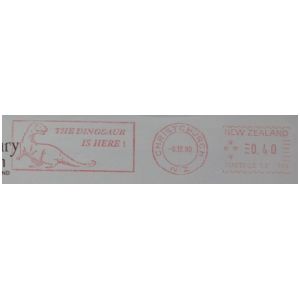 |
 |
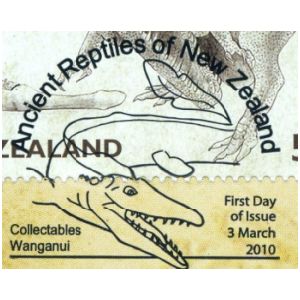 |
| 03.03.2010 "Ancient Reptiles of New Zealand" [FDC] [C2] | ||
 |
|
|
Notes:
 [C1] Dinosaur vertebrate on postmark of New Zealand that used on FDC.
[C1] Dinosaur vertebrate on postmark of New Zealand that used on FDC.
[C2] The silver postmark used on FDC from "Limited Edition Pack" which included a numbered gummed miniature sheet specifically designed for this edition, a signed first day cover, a full set of stamps, colour separations of the $2.80 stamp and insightful commentary by renowned New Zealand geologist and palaeontologist Dr Hamish Campbell.
Some other commemorative postmarks of New Zealand to consider: contributors to Paleontology
Legend is here| 21.12.2001 "Centenary of the first British Antarctic Expedition - Robert Falcon Scott" [Sp] [CO1] | ||
 |
|
|
Notes:
[CO1] Robert Falcon Scott CVO (6 June 1868 – 29 March 1912) was a Royal Navy officer and explorer who led two expeditions to the Antarctic regions: the Discovery expedition of 1901–1904 and the ill-fated Terra Nova expedition of 1910–1912.
Scott and his companions died on the second expedition. When Scott and his party's bodies were discovered, 16kg of Glossopteris (an extinct beech-like tree from 250 million years ago) fossils from the Queen Maud Mountains were found next to their bodies, which they had dragged on hand sledges.
These fossils were promised to Marie Stopes (shown on UK stamp in 2008) to provide evidence for Eduard Suess's idea that Antarctica had once been part of an ancient super-continent named Gondwanaland (now Gondwana).
More details are here.
References:
- [R1] New Zealand:
Wikipedia,
WikiTravel,
FlagCounter.
- [R2] Postal History and Philately of New Zealand:
Wikipedia,
Links to official website of the Post Authority, stamp catalog and a list of new stamps of New Zealand are here - [R3] Sir James Hector:
Wikipedia.
"A bibliography of publications by or about James Hector (1834-1907)", by Simon Nathan, Rowan Burns & Esme Mildenhall. Geoscience Society of New Zealand miscellaneous publication 133M March 2015 - [R4] Te Papa Museum of New Zealand: official homepage.
Acknowledgements:
Many thanks to Dr. Peter Voice from Department of Geological and Environmental Sciences, Western Michigan University, for reviewing the draft page and his valuable comments.
| << previous country | back to index | next country >> |